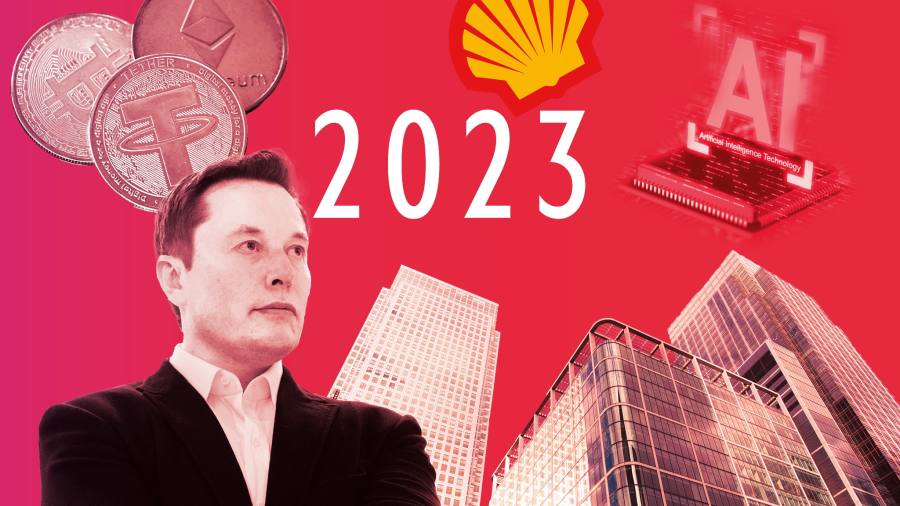This time last year, companies were wondering if there was an end in sight to the Covid-19 pandemic. Then in February, Russia launched a full-scale invasion of Ukraine, creating major ructions in markets from oil and gas to food and unsettling investors around the world.
Some industries have been particularly affected by the economic reordering: this is what to look for in the coming year in the corporate world in sectors from energy to private capital and technology.
Energy
Trend to watch
2023 could represent a new era in energy: the beginning of a partitioned global oil market. For the past three decades, energy, particularly oil, has generally flowed freely around the world to the highest bidder. European and US sanctions on Russian exports have turned that market on its head, in effect dividing the world once again between east and west.
Russian energy exports that used to flow to Europe will now head towards India and China. US exports will flow to Europe and shipments from the Middle East may plug gaps in both directions. How this new system performs, whether the sanctions regimes work and who steps in to trade Russian energy will drive prices in the next 12 months and potentially for years to come.

Biggest risk
Authorities in the US and Europe are gradually moving towards increased regulation of climate targets and emissions reporting. The US Securities and Exchange Commission in March proposed measures that would make companies disclose data about carbon emissions in their annual reports. Under the recently passed Inflation Reduction Act, “excess” methane emissions in the US will be penalised from 2024. In Europe, Shell’s appeal against a landmark ruling on its emissions reduction targets is ongoing.
This year is likely to see more litigation and more pressure for increased regulation, with direct consequences for how energy companies plan, operate and report.
Person to watch
Wael Sawan takes the helm at Shell, Europe’s biggest energy company this month, replacing Ben van Beurden who spent nine years as chief executive.
Sawan, a Shell lifer, inherits a company making record profits but still facing big questions about its future. Officially, he has been appointed to implement the energy transition strategy developed by van Beurden. But even a slight change in approach or tone would have significant implications for the sector, given Shell’s size and influence.
Principally Sawan must decide whether to direct more of the company’s huge hydrocarbon-driven profits into low-carbon energy, or whether the current crisis justifies maintaining oil and gas production levels for longer.
What would be the biggest surprise?
Will any of the biggest western oil and gas majors significantly increased their existing climate pledges? Much more aggressive cuts in fossil fuel production and consumption are required for the world to stand any chance of keeping warming below 2C. However last year’s energy crisis revived fears about energy security, presenting an opportunity for industry groups to argue in favour of continued investment in oil and gas during the transition.
Tom Wilson in London
Technology
Trend to watch
Artificial intelligence has taken a leap into the mainstream with “generative” systems that write, or create images that look like they came from a human. With capital flooding into the sector, the race is on to turn these systems into the foundation for a new mass-market computing platform.
ChatGPT, the conversational system launched by OpenAI in late 2022, demonstrated how this new form of AI could transform the way people work with computers. The coming year is likely to bring developments on many fronts, as the capabilities of generative systems extend into areas such as producing video and audio, and as tech companies compete to apply the technology to everyday work, communication and entertainment.
Person to watch
Elon Musk: Who else? For the third year in a row, Musk gets the Financial Times’s pick as the techie to watch in 2023 — though this time, it may be for all the wrong reasons. Even if he makes good on a promise to step aside as the chief executive of Twitter, his personal ownership and near-constant presence guarantee that his antics at the social media company will keep him in the headlines.
Of greater importance to the tech world, however: will Musk get back to what he does best, helping to turn electric vehicles and space rockets into important new industries? His giant Starship rocket could soon get its first orbital test launch, potentially ushering in an era of much lower-cost space flight. And after a 63 per cent slide in its stock price from the peak, Tesla shareholders will be hoping Musk has his sights in 2023 set squarely on consolidating his lead in the fast-growing EV market.

Biggest risk
A severe change in the financial climate in 2022 has already hit tech hard, letting the air out of the bubble in growth stocks. This would be compounded if an economic downturn follows in 2023, turning a sharp valuation adjustment into a broad-based rout in the industry.
Many tech companies have already been struggling to deal with the aftermath of the boom, cutting workers and paring back investments. An economic crunch that also hit demand for their products and services would force many companies to cut much deeper and threaten to turn the post-Covid hangover into an outright tech depression.
What would be the biggest surprise?
If one of the big tech companies decides to voluntarily spin off a significant part of its business, without waiting to have its hand forced by regulators.
The sheer scale of the biggest tech giants has made them increasingly difficult to manage. And with regulators breathing down their necks, there is a risk that senior managers will become distracted and overly cautious. What better answer than to unpick parts of their operations and attempt a return to their entrepreneurial roots?
Richard Waters in San Francisco
Private Capital
Trend to watch
Private equity giants such as Blackstone, CVC and KKR are considered “patient capital”. Their funds can last a dozen years or longer, affording them the luxury to wait out shifts in markets caused by unexpected events such as the war in Ukraine.
Time is now becoming their enemy. Soaring interest rates have nearly doubled interest costs for many leveraged portfolio companies. It transfers value to lenders and creates a headache as debt maturities near.
Frozen capital markets, meanwhile, have made it hard to sell businesses and return capital, creating illiquidity problems for investors and cutting cheque sizes for new funds. The clock is ticking on valuations, too. Buyout groups are slow to mark down their portfolios when markets fall. Year-end audits, however, may finally force them to acknowledge writedowns from tumbling public market values.
Biggest regulatory risk
Jonathan Kanter, the head of the Department of Justice’s antitrust unit, is leading a sweeping reform of enforcement that gives much more focus to private equity.
Kanter is worried about the size and influence of the industry, telling the FT “we’re seeing a once-in-many generation(s) shift in how markets function” and a “once-in-century inflection point in terms of reach of corporate power”.
Already, his tougher enforcement approach has caused dealmakers to rethink mergers and forced a number of executives to resign from overlapping corporate board seats. It is an opening salvo.

Person to watch
Orlando Bravo, the billionaire co-founder of Thoma Bravo, has stood out for his ability to raise capital and quickly invest it. In about two years, his firm has raised more than $55bn and agreed to take more than a dozen public software companies private.
Bravo remained aggressive last year, agreeing to leveraged buyouts for seven listed companies since Russia’s full-scale invasion of Ukraine. He will now have to show he did not overpay, as rising interest rates hit technology valuations and ballooning financing costs eat into cash flows.
Pension and sovereign wealth investors will be watching closely.
In recent deals, Thoma Bravo has used as much as $8bn in equity to clinch takeovers, relying on unconventionally large direct investments from deep-pocketed investors. Whether these deals can earn sufficient returns remains to be seen.
What would be the biggest surprise?
A classic playbook in private equity is to increase the size and geographic reach of investments with acquisitions, creating economies of scale. The same strategy may apply to buyout groups themselves as they merge with larger asset managers such as BlackRock.
Larry Fink has resisted large deals in alternative assets but tumbling market multiples may present the opportunity to hunt for big game. The rise of the retail market and slowing industry growth has only bolstered the value of BlackRock’s distribution capability for potential sellers.
Antoine Gara in New York
Commercial property
Trend to watch
No-one involved in commercial property anticipates an easy ride in 2023. A downturn has already begun and is expected to worsen. The question being asked by analysts and investors is: how far will the market fall before it reaches a new equilibrium?
Owners of offices, shops and warehouses around the world were still figuring out what impact the pandemic has had on their tenants when they were hit by rising interest rates last year.
The market is recalibrating as the long era of cheap money, which has drawn so many new investors to the sector since the financial crisis, comes to a juddering halt.
Higher borrowing costs, inflation and the threat of recession will push some landlords to the brink in 2023, and the expectation is that forced sales will begin in earnest within the first half of the year, as property owners have to refinance loans at far higher rates or sell assets to meet redemption requests from their own investors.

Person to watch
Sandeep Mathrani took over as WeWork boss in 2020 with a simple promise: he would drag the shared office company to profitability.
Once the poster child for fast-growth start-ups, WeWork became a story of corporate hubris as its $47bn valuation tumbled and a public listing floundered in 2019.
Mathrani has avoided the spotlight his predecessor Adam Neumann relished and slashed costs, but WeWork remains lossmaking. Mathrani’s ability to turn a profit in 2023 will give some indication of how other debt-laden companies will fare in the fast-changing world of work.
Biggest risk
In 2022, the phrases “stranded assets” and “zombie offices” drifted into the lexicon of property agents and investors. Both describe the slew of older workplaces that will fall short of new environmental legislation that is being phased in.
This year that new regulation will continue to eat away at the value of offices. Landlords will need to invest in their buildings to meet new rules and keep attracting tenants. But against a grim economic backdrop, their ability to do so will be severely tested.
What would be the biggest surprise?
A return to the “old normal” for office landlords. Throughout the pandemic, even as workplaces were completely emptied, property owners maintained that the good times would return and staff would flood back given the chance. That idea now looks fanciful. Occupancy rates are half pre-pandemic levels in the UK and remain far down in the US too: hybrid working looks like it is here to stay.
George Hammond in London
Cryptocurrencies
Trend to watch
After a major market crash in the summer — defined by job cuts, insolvencies and the collapsing price of tokens such as bitcoin and ether — the industry was rocked again in November by the bankruptcy of crypto exchange FTX.
Its collapse has undermined one of the industry’s sacred tenets: that decentralisation is its fundamental feature and strength. Recent data also suggests concentration and centralisation. Data provider CryptoCompare found that Binance, the world’s largest exchange, has a more than 60 per cent share of spot and derivative crypto markets.
The crypto industry lost an array of once-prominent businesses last year and the question of decentralisation is likely to arise again in 2023.

Person to watch
The downfall of Sam Bankman-Fried means the troubled crypto space needs a new advocate.
Cathie Wood’s Ark Investment Management has lost almost $50bn in assets from its exchange traded funds since its 2021 peak, but the outspoken bitcoin evangelist may become an industry flagbearer in 2023.
Unshaken by the collapse of Bankman-Fried’s FTX in November, Wood has predicted bitcoin will be valued at $1mn by 2030.
However bitcoin has endured a horrible 12 months, losing more than 60 per cent of its value since January 2022. If the industry’s flagship token recovers this year, Wood’s unwavering faith in “disruptive innovation” will not be far behind.
Biggest risk
In the aftermath of FTX’s collapse, crypto exchanges are under scrutiny from consumers and regulators asking whether they are financially stable.
Some exchanges have since committed to issuing proofs of reserves. Binance has said it holds more than $60bn in assets, enough to meet customer withdrawals.
Yet, the company’s disclosures do not include its liabilities, making it difficult to ascertain its financial health. In a market now plagued by consumer anxiety, the stability of businesses such as Binance remains a big worry for regulators and consumers.
What would be the biggest surprise?
Before he became SEC chair, Gary Gensler won a certain amount of popularity among crypto enthusiasts for teaching a course on blockchain technology at the Massachusetts Institute of Technology.
Since then, his tough regulatory stance on crypto has lost him support among many industry advocates. It would be a huge surprise if they learnt to love him again.
Scott Chipolina in London



